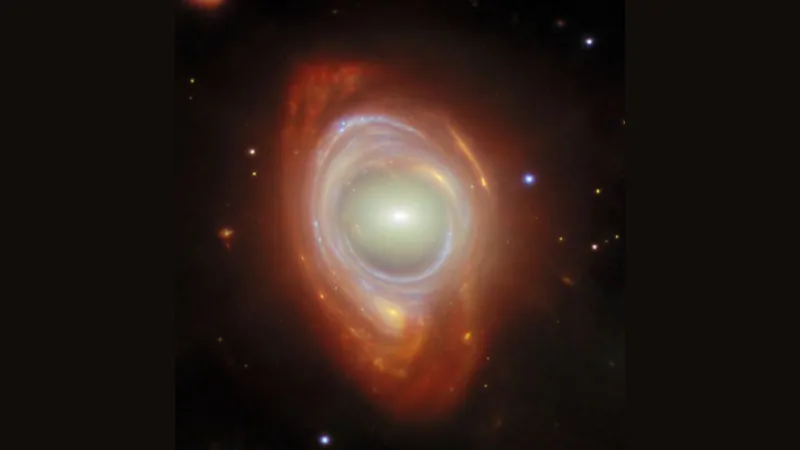
James Webb Telescope Unveils Stunning 'Einstein Ring' That Breaks Cosmic Illusions!
2025-03-27
Author: Li
James Webb Space Telescope Unveils Rare Cosmic Phenomenon
The James Webb Space Telescope (JWST) has recently unveiled an extraordinary image of a truly rare cosmic illusion known as an Einstein ring, captivating astronomers and space enthusiasts alike. This optical phenomenon, which looks like an eerie eye in the vastness of space, actually represents a unique view of two distant galaxies in the constellation Hydrus.
Understanding Gravitational Lensing
At the center of this mesmerizing cosmic display is one galaxy, surrounded by a vibrant swirl of orange and blue light that emanates from another, more remote galaxy obscured behind it. The captivating ring shape is a result of gravitational lensing, a remarkable effect caused by the gravitational pull of massive celestial objects distorting the light from objects farther away.
Einstein’s Theory of Relativity
Gravitational lensing is no mere trick of the light—it's a magnificent consequence of Albert Einstein’s theory of relativity. The theory posits that massive bodies, such as galaxies or black holes, warp the fabric of space-time, thereby bending the trajectories of light traveling through that warped space. This means that light from distant galaxies can take a detour, resulting in stunning visual effects that can be observed only in vast cosmic scales.
Joint Release by Space Agencies
European Space Agency (ESA) officials expressed the rarity and beauty of this phenomenon in a recent statement: “This effect is much too subtle to be observed locally, but it becomes strikingly clear when viewed on astronomical scales.” The latest breathtaking image was jointly released by ESA and the Canadian Space Agency, showcasing JWST’s Near-InfraRed Camera, along with data from the Hubble Space Telescope’s Wide Field Camera 3 and Advanced Camera for Surveys instruments.
Mechanics of Einstein Rings
Einstein rings occur when the light source, the lensing object, and the observer achieve perfect alignment, forming a complete ring. This particular Einstein ring results from the intense gravitational well created by an elliptical galaxy, which is part of the galaxy cluster SMACSJ0028.2-7537. The sheer mass of this foreground galaxy warps the light of the spiral galaxy situated behind it, creating the spectacular visual effect observed.
Astronomical Insights Through Lensing
What's more, even with the distortion of its light, astronomers can discern individual star clusters and gas structures within the ring, allowing for an unparalleled glimpse into the cosmos. This striking visualization not only highlights the beauty of the universe but also serves as a vital tool for astronomers seeking to uncover the mysteries of dark matter and black holes, which do not emit light themselves.
Revolutionizing Cosmic Research
Gravitational lensing is revolutionizing our understanding of the universe. Light from early galaxies, some of which existed mere moments after the Big Bang, is often too faint to detect directly from Earth. Nevertheless, strong gravitational lensing magnifies these distant galaxies, enhancing their visibility and enabling astronomers to study origins of cosmic structures.
A Laboratory for Invisible Galaxies
"These extraordinary objects serve as the perfect laboratory for probing galaxies that would otherwise remain invisible," the ESA statement elaborated.
Conclusion
So, as the James Webb Space Telescope continues to explore the vast ocean of space, it not only provides us with breathtaking images but also deepens our understanding of the cosmic forces at play, shaping the universe as we know it. Get ready for more astonishing revelations as we embark on this journey through space!




 Brasil (PT)
Brasil (PT)
 Canada (EN)
Canada (EN)
 Chile (ES)
Chile (ES)
 Česko (CS)
Česko (CS)
 대한민국 (KO)
대한민국 (KO)
 España (ES)
España (ES)
 France (FR)
France (FR)
 Hong Kong (EN)
Hong Kong (EN)
 Italia (IT)
Italia (IT)
 日本 (JA)
日本 (JA)
 Magyarország (HU)
Magyarország (HU)
 Norge (NO)
Norge (NO)
 Polska (PL)
Polska (PL)
 Schweiz (DE)
Schweiz (DE)
 Singapore (EN)
Singapore (EN)
 Sverige (SV)
Sverige (SV)
 Suomi (FI)
Suomi (FI)
 Türkiye (TR)
Türkiye (TR)
 الإمارات العربية المتحدة (AR)
الإمارات العربية المتحدة (AR)